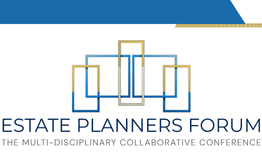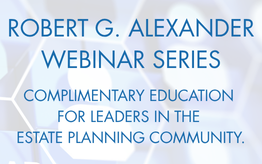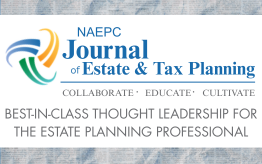The Collaboration Corner
brought to you by the NAEPC Multi-Disciplinary Teaming Committee
Philanthropic Planning: Leading with the Right Questions by Phil Cubeta, CLU®, ChFC®, MSFS, AEP®, CAP®
From the Jan/Feb Issue of NAEPC News
As someone who is seen as a charitable specialist, I was recently brought into an estate planning team after the attorney, CPA, and financial advisor had crafted a plan for a client and spouse who had exited a closely -held business at age 45. The proceeds were large enough that the couple now had an estate an estate tax issue. To eliminate estate tax, the team had determined the clients needed a donor advised fund, a charitable lead trust, or a private foundation at death. Other than these details, the plan was finished. In fact, it was already bound in hardcover. My role was to explain the differences among the testamentary charitable tools.
I asked the couple what causes moved them. They said they were interested in helping autistic children since the husband had an autistic sister. Asked if the heirs would welcome the responsibility of helping autistic children via a tool, the parents said, no. The heirs had no interest in philanthropy, much less in autistic children. I then asked when the couple would like to make a difference for the cause, now, later, at death, or after death. They said, “Now, of course, we have the money. We want to make an impact as soon as possible.”
What the couple needed was a cash flow analysis to see how much they could afford to give either outright to a charity now, or in installments via a tool. They asked if the firm could do that for them, and of course the firm could.
We talked more about the tools. As entrepreneurs they simply could not get comfortable with the role, as they saw it, of bankers, doling out dollars to someone else who would do the work for the families with autism. In the end, they decided to start a new for-profit social venture to provide resources and education to families with special needs children.
The moral of the story is that philanthropic work begins with questions about purpose. Whether it lands on a donor advised fund, foundation, or social enterprise depends on not only tax and cash flow issues, but also on the difference the funder wishes to make in the world. It also depends on when the client wants to see change. And, it depends on how actively engaged the funder wishes to be. Exploring these larger questions about purpose and timing should precede and guide the technical planning. Ideally, these questions should be asked early, by the lead advisor, not left to a charitable specialist at the tag end of the process.
Sample framing questions
- What would you like to change or preserve in the world?
- When would you start, if you knew you could afford it?
- How actively engaged do you want to be?
- Do you want to provide the service or give to those who do?
- What about investing? Could you align your investments with those social goals?
- Do you and your heirs share a vision as to the difference you want to make in the world?
- Is this primarily about making a difference in the world? Or, do you see it as being primarily about the difference it might make for you and your family?
- How might we get the other family members engaged?
Teaming Publications
Following is a list of publications that we feel demonstrates the team concept and spirit of collaboration.
Book: "The Five Dysfunctions of a Team" by Patrick Lencioni
NAEPC Notes: In this book Patrick Lencioni reveals the basics of teamwork by using a leadership fable, a story of a technology company that is struggling to grow and find customers. The team struggles to accept responsibilities and come to any agreements, resulting in negative morale. Throughout the fable the five dysfunctions of their team become evident, i.e. absence of trust, fear of conflict, lack of commitment, avoidance of accountability and inattention to team results. These five dysfunctions are universally applicable to families of wealth, family enterprises, and professional advisor teams. This book can be purchased at Amazon.com or your favorite retailer.
Book: "The Advantage: Why Organizational Wealth Trumps Everything Else in Business" by Patrick Lencioni
NAEPC Notes: High-performance teaming starts with strong leadership. It is first and foremost, the result of a collaborative team that works closely together to make things clear. This requires cohesiveness in vision for the family and their professional advisor team, as well as in their respective relationships. Patrick Lencioni distills everything down to six critical questions which enable the team to define and bring purpose to their association: Why do we exist? How do we behave? What do we do? How do we succeed? What is most important, right now? Who must do what? Anyone on the team can operate effectively, in alignment with the clients’ goals and values, when the leaders have clearly communicated the answers to these questions. This book can be purchased at Amazon.com or your favorite retailer.
Book: "The Fifth Discipline: the Art and Practice of the Leaning Organization" by Peter M. Senge
NAEPC Notes: Estate Planning is a highly complex, multidisciplinary project, and when done most successfully, engages the services of a team of professionals who work in close collaboration with one another, and with the family. Collaboration is both a learning experience and creative activity. To do it well the professional advisor team must understand all the interactions, interdependencies and interrelationships between and amongst the professionals and their respective disciplines. It requires systems thinking, which Peter Senge defines as the fifth discipline. When a professional advisor team collaborates at a high level, they will successfully tap into and harness the collective wisdom of the group. They will become a learning organization. This book can be purchased at Amazon.com or your favorite retailer.
Book: "Extraordinary Leadership: Thinking Systems, Making a Difference" by Roberta M. Gilbert, M.D.
NAEPC Notes: Estate Planning is complex both from a technical perspective, but also from a social perspective. Relationship systems, which include families of wealth, family enterprises and professional advisor teams, are governed by an insidious emotional process. It operates automatically and subconsciously, and oftentimes distracts a group from accomplishing their collective goals. What we think and feel, or what we say and do, are affected by, and influence what others think and feel, and what they say or do. When anxiety rises in the relationship system, participants assume predictable postures and patterns. Seeing and managing emotional process is key to getting things done and making things happen in a collaborative environment. This book is a must read for any advisor who is looking to become an extraordinary leader, and who seeks to learn how to collaborate at the highest level. This book can be purchased at Amazon.com or your favorite retailer.
Book: “Smart Collaboration: How Professionals and Their Firms Succeed by Breaking Down Silos” by Heidi K. Gardner
NAEPC Notes: In Smart Collaboration, Gardner argues that firms earn higher margins, inspire greater client loyalty and gain a competitive edge when the collaborate across functional boundaries. She also says that, unless you know why you are collaborating and how to do it effectively, it may not be a good idea at all. Most of the book is targeted at larger firms and collaboration across silos within these firms. Gardner has much to say to leaders about the importance of fostering collaboration across channels in the firm and breaking down the barriers that may inhibit collegial work. Chapter 3, entitled, “Collaboration and the Solo Specialist” is directly relevant to multi-disciplinary teaming in the way that most NAEPC members might think about it. Any professional who in interested in effective collaboration principles and wants to learn from those who have worked in a variety of disciplinary channels will learn from this book. This book can be purchased at Amazon.com or your favorite retailer.
Article: "Professional Collaboration" by John T. Midgett, JD, AEP®
Reprinted with permission of Trusts & Estates
Article Description: Clients typically have a number of estate-planning related issues with which they need our help. Often, to achieve the best results, it’s important to collaborate with other professionals. To get a better idea how the various players work together, let’s follow a hypothetical attorney, Tom, from the time he learns of possible new clients through his initial meeting with them, and see how he effectively uses teamwork to address the clients’ issues.
Download the Article HERE.
Article: "How Collaborative Teams Work and Why they are Essential for High-Net-Worth Clients" by Albert E. Gibbons, CLU®, ChFC®, AEP® (Distinguished)
Article Description: Albert Gibbons details the elements required to organize a successful collaborative team and provides a step-by-step approach used in collaborative estate planning.
Download the Article HERE.
Article: "Better Results through Better Collaboration" by David W. Holaday
Article Description: David W. Holaday shares his insights about establishing frameworks and processes for shaping a client’s individual advisors into a smoothly functioning group that will work collaboratively for the mutual benefit of the client and the advisors.
Download the Article HERE.
Book: "The Right Side of the Table" by Todd Fithian
Description: This book was written to help advisers in a variety of business life cycles make an intentional choice about the next decades of their careers. The title introduces a metaphor surrounding the proverbial conference room table. It suggests that as wealth increases in our society, wealth holders are demanding a different model for assembling their team of professional advisers. Team members will take specific seats at the table, next to or across from the wealth holder, based on the role they are best suited to play. As more and more advisers adopt authenticity in their selection, wealth holders will become savvier to those trying to disguise their underlying relationship goals. Advisers must be clear about where they're meant to sit and why. It's also about helping our clients get to the root of their intent. So much of financial services is focused on tax savings and tax elimination. Yet for people who have financial independence, that can't possibly be their ultimate goal for their wealth. How could it? Life has so much more to offer. To help wealth holders find the true intent for their wealth requires deep discovery, skillful discovery. It requires conversations in which there isn't a single product idea, service mix, or technical strategy dangling in the back of the adviser's mind. The quality of the wealth holder's choices increases in direct proportion to the quality of discovery used to facilitate them. This is a discernment-based style of communication, which is the foundation of our teachings and of this book. We believe that soon there will be a discernment-based adviser at every planning table. In the Right Side of the Table model, successful advisers will embrace an abundance mentality, inviting additional advisers to the table to fill roles the core team isn't suited to play. The opportunities for professional advisers are tremendous. The time has come to make an intentional and wise choice. Which is the right side of the table for you?
This book can be purchased at Amazon.com or your favorite retailer.
See Guide to Teaming.





